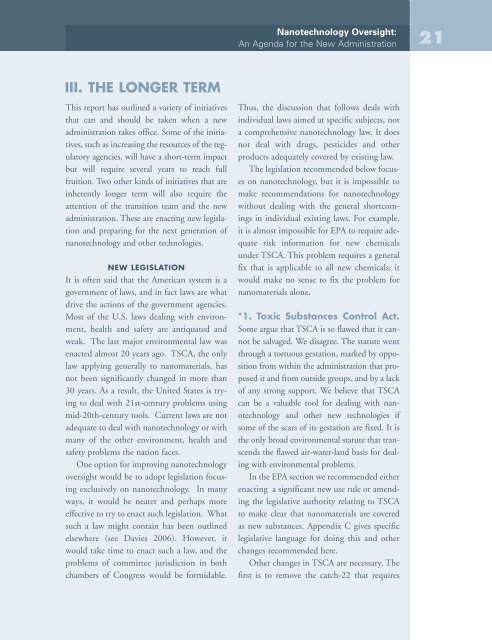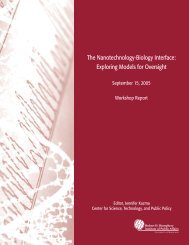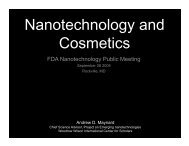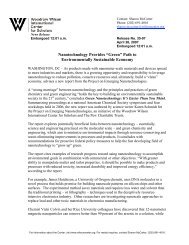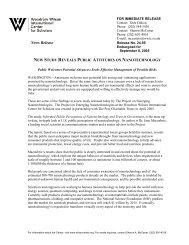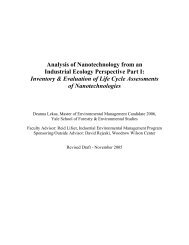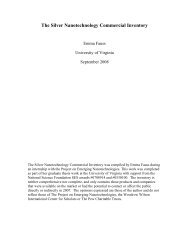nanotechnology oversight - Project on Emerging Nanotechnologies
nanotechnology oversight - Project on Emerging Nanotechnologies
nanotechnology oversight - Project on Emerging Nanotechnologies
You also want an ePaper? Increase the reach of your titles
YUMPU automatically turns print PDFs into web optimized ePapers that Google loves.
Nanotechnology Oversight:<br />
An Agenda for the New Administrati<strong>on</strong><br />
21<br />
III. THE LONGER TERM<br />
This report has outlined a variety of initiatives<br />
that can and should be taken when a new<br />
administrati<strong>on</strong> takes office. Some of the initiatives,<br />
such as increasing the resources of the regulatory<br />
agencies, will have a short-term impact<br />
but will require several years to reach full<br />
fruiti<strong>on</strong>. Two other kinds of initiatives that are<br />
inherently l<strong>on</strong>ger term will also require the<br />
attenti<strong>on</strong> of the transiti<strong>on</strong> team and the new<br />
administrati<strong>on</strong>. These are enacting new legislati<strong>on</strong><br />
and preparing for the next generati<strong>on</strong> of<br />
<str<strong>on</strong>g>nanotechnology</str<strong>on</strong>g> and other technologies.<br />
NEW LEGISLATION<br />
It is often said that the American system is a<br />
government of laws, and in fact laws are what<br />
drive the acti<strong>on</strong>s of the government agencies.<br />
Most of the U.S. laws dealing with envir<strong>on</strong>ment,<br />
health and safety are antiquated and<br />
weak. The last major envir<strong>on</strong>mental law was<br />
enacted almost 20 years ago. TSCA, the <strong>on</strong>ly<br />
law applying generally to nanomaterials, has<br />
not been significantly changed in more than<br />
30 years. As a result, the United States is trying<br />
to deal with 21st-century problems using<br />
mid-20th-century tools. Current laws are not<br />
adequate to deal with <str<strong>on</strong>g>nanotechnology</str<strong>on</strong>g> or with<br />
many of the other envir<strong>on</strong>ment, health and<br />
safety problems the nati<strong>on</strong> faces.<br />
One opti<strong>on</strong> for improving <str<strong>on</strong>g>nanotechnology</str<strong>on</strong>g><br />
<str<strong>on</strong>g>oversight</str<strong>on</strong>g> would be to adopt legislati<strong>on</strong> focusing<br />
exclusively <strong>on</strong> <str<strong>on</strong>g>nanotechnology</str<strong>on</strong>g>. In many<br />
ways, it would be neater and perhaps more<br />
effective to try to enact such legislati<strong>on</strong>. What<br />
such a law might c<strong>on</strong>tain has been outlined<br />
elsewhere (see Davies 2006). However, it<br />
would take time to enact such a law, and the<br />
problems of committee jurisdicti<strong>on</strong> in both<br />
chambers of C<strong>on</strong>gress would be formidable.<br />
Thus, the discussi<strong>on</strong> that follows deals with<br />
individual laws aimed at specific subjects, not<br />
a comprehensive <str<strong>on</strong>g>nanotechnology</str<strong>on</strong>g> law. It does<br />
not deal with drugs, pesticides and other<br />
products adequately covered by existing law.<br />
The legislati<strong>on</strong> recommended below focuses<br />
<strong>on</strong> <str<strong>on</strong>g>nanotechnology</str<strong>on</strong>g>, but it is impossible to<br />
make recommendati<strong>on</strong>s for <str<strong>on</strong>g>nanotechnology</str<strong>on</strong>g><br />
without dealing with the general shortcomings<br />
in individual existing laws. For example,<br />
it is almost impossible for EPA to require adequate<br />
risk informati<strong>on</strong> for new chemicals<br />
under TSCA. This problem requires a general<br />
fix that is applicable to all new chemicals; it<br />
would make no sense to fix the problem for<br />
nanomaterials al<strong>on</strong>e.<br />
*1. Toxic Substances C<strong>on</strong>trol Act.<br />
Some argue that TSCA is so flawed that it cannot<br />
be salvaged. We disagree. The statute went<br />
through a tortuous gestati<strong>on</strong>, marked by oppositi<strong>on</strong><br />
from within the administrati<strong>on</strong> that proposed<br />
it and from outside groups, and by a lack<br />
of any str<strong>on</strong>g support. We believe that TSCA<br />
can be a valuable tool for dealing with <str<strong>on</strong>g>nanotechnology</str<strong>on</strong>g><br />
and other new technologies if<br />
some of the scars of its gestati<strong>on</strong> are fixed. It is<br />
the <strong>on</strong>ly broad envir<strong>on</strong>mental statute that transcends<br />
the flawed air-water-land basis for dealing<br />
with envir<strong>on</strong>mental problems.<br />
In the EPA secti<strong>on</strong> we recommended either<br />
enacting a significant new use rule or amending<br />
the legislative authority relating to TSCA<br />
to make clear that nanomaterials are covered<br />
as new substances. Appendix C gives specific<br />
legislative language for doing this and other<br />
changes recommended here.<br />
Other changes in TSCA are necessary. The<br />
first is to remove the catch-22 that requires


